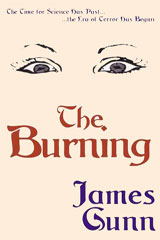
The nightmare began with the House Un-American Activities Committee and Senator Joseph McCarthy. We lived in Wisconsin for a year and a half where I had a job as a junior editor of paperback books but left in the fall of 1952 to return to full-time writing in Kansas City, but not before we had a chance to cast a vote against McCarthy. While we were in Wisconsin, my wife Jane went to a McCarthy campaign rally and reported that McCarthy had a personal magnetism that made her understand how people could be swayed by him. In 1953 we bought our first television set. In 1954, we were glued to it by the Army-McCarthy hearings. In 1955 I began thinking about an idea for a short novel that dealt with the American anti-intellectualism I saw as the reason for the success of HUAC's and Senator McCarthy's witch-hunts. They were acceptable because people were eager to believe that writers, film-makers, academics, and scientists would betray their country in the name of their soft-headed ideals. Emotions seemed heated enough to spill over into mob action.
I wanted to write about the way in which attitudes had changed toward the wise men of the community, the sachems, the witch doctors. Once they were considered gifted with special powers that they used in behalf of the tribe to placate or manipulate the supernatural forces and beings that controlled the world. They were special; they were revered. But in modern times, when everybody could educate themselves to wisdom and power over nature, people saw themselves as victims of scientific and technological change that were being created by scientists. They believed that scientists were pursuing knowledge without considering how it would be used and that ordinary humanity paid the price. The story I contemplated imagined a revolution from which, eventually—in two sequels that might be combined with the first story into a novel—science would be restored to its original position as a respected member of the tribe with a special talent for making miracles.
In 1956 I exchanged some letters with John W. Campbell, the editor of Astounding. In his characteristic contrarian way, Campbell took the opposite position—that people had a right to be upset at the scientists, and my scientist, fleeing from their righteous anger, ought to realize this and return to give himself up. I was convinced—or, if not convinced, persuaded, since it was Campbell who would authorize payment, wrote "Witches Must Burn," and saw it published in Astounding in August 1956. But the sequels I had planned got hung up on my inability to get past the ending of that short novel to the beginning of the next. Twelve years later I finally realized why my hero had returned (it wasn't Campbell's reason), and I wrote "Trial by Fire." Frederik Pohl accepted it. " Witch Hunt" followed immediately, and the two short novels were published within a couple of months of each other—"Trial by Fire" in the February 1969 issue of If, "Witch Hunt," in the April 1969 Galaxy.
That same year the World Science Fiction Convention was held in St. Louis. I took my two teen-aged sons and a friend of my older son. There we met a charming young woman named Gail Wendroff who had just been named science-fiction editor at Dell Books. We invited her to join us at the Hugo Awards. She told me later that she had felt so out-of-place that she was about to return to New York. Perhaps it was no coincidence that a year later she published The Witching Hour and two years after that, The Burning.
–James Gunn